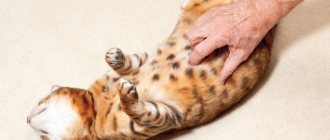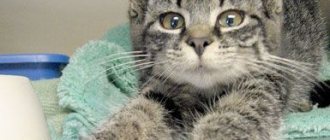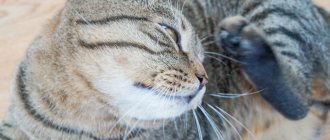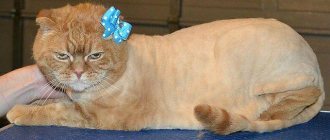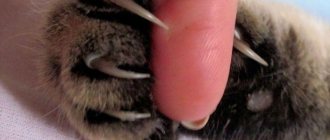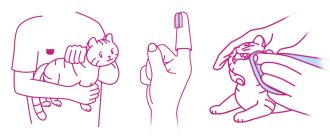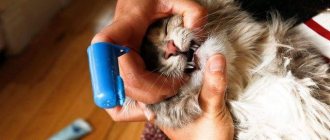Massage is as beneficial for animals as it is for humans. This type of physiotherapy can relieve pain and inflammation, speed up the resorption of hematomas, increase muscle tone, and improve joint mobility. There are soothing-relaxing and therapeutic-prophylactic types of massage. The first cat owners use unconsciously is light stroking, scratching the back, belly and head of the animal.
Therapeutic massage is prescribed by a veterinarian. The technique for performing this procedure depends on the reason for its purpose. Most often, veterinarians prescribe back or paw massage for cats. It is advisable that the first session be conducted by the doctor himself, and in the future, having mastered the necessary techniques, the animal owner will be able to do it independently.
Indications for massage
The main task of massage during constipation is to normalize the functioning of the intestines, improve the elasticity of its walls and help the movement of feces.
Abdominal massage is recommended for cats with the following types of problems:
- Chronic constipation, when the animal constantly takes laxatives for constipation. This disrupts normal intestinal motility.
- Constipation that arose against the background of stress factors. In this case, you can limit yourself to massage only without the use of folk or medicines. In this case, of course, eliminate the source of stress.
- Sedentary lifestyle. Most often, constipation occurs in animals older than 7 years, whose activity is reduced.
- Change of diet or incorrectly selected cat diet. Typically, diets that are low in fiber lead to bowel problems.
Normally, a cat goes to the toilet approximately once a day. For pets over 7 years old, visits to the toilet may be less frequent - once every 2 days. If a cat does not have a bowel movement for 3 days, this is a clear sign of constipation. Other symptoms: anxiety, the cat sits in the tray, strains, but nothing happens, refuses to eat. The owner can try to help the pet on his own. The first thing you need to start with is to do an abdominal massage.
Massage treatments for cats
From a medical point of view, the benefits of properly performed massage are obvious. It relieves muscle spasms, accelerates the saturation of blood vessels with oxygen and nutrients, and eliminates toxins. Stimulates the circulatory and lymphatic systems. As a therapeutic agent, it helps in the healing of injuries and recovery after operations. For animals suffering from arthritis, this is a real way to relieve pain. During the procedure, it is easy to examine the pet’s body for the presence of tumors and wounds, parasites or ticks.
When massaging, feel and remember all the features of your pet’s body, pay attention to changes
Among other things, cat massage has an impact on behavioral factors and psychological health, as it helps in getting rid of depression, reduces stress levels, and stimulates the production of the joy hormone - endorphin. Aggressive behavior is also regulated by massage procedures.
Nothing relaxes you like the owner's hands
Volunteers at pet shelters note the enormous benefits of touching their charges. They claim that pets that are massaged for at least 3-5 minutes a day find new owners much faster. Animals become calmer and more balanced. They make contact with people more easily, are inclined to communicate, and trust people.
For cats and dogs who find themselves in difficult life situations, the procedure becomes not a luxury, but a necessity.
When should you not massage your cat?
Any procedures or treatments should be discussed with your veterinarian. He will tell you how to act in a given situation, what types of massage are indicated for your pet and whether they are indicated at all.
Contraindications are cancer in the animal, as well as elevated body temperature. The procedure cannot be performed on open wounds or bone fractures. You should not test your cat's strength if he feels pain from touching. Such rubbing will not make him feel any better. Do not massage tumors or areas around them. If Murka has problems with blood clotting, the procedure should be carried out with caution and only after consultation with a veterinarian. Rubbing the belly is not recommended for a pregnant cat, but she would probably not refuse massaging the head, withers and back.
When is massage harmful?
There are some contraindications for cat massage:
- Vomiting, dehydration, high temperature (more than 39.5 degrees) are a sign that constipation is a symptom of another serious disease. You need to see a doctor.
- If there are areas of skin with damage.
- Diseases of internal organs.
- Hernias, intestinal tumors. Mechanical impact can cause the tumor to increase in size and even transform into cancer.
- Intestinal volvulus.
- Blockage of the intestines by a foreign object.
- You cannot massage cats on your own during pregnancy.
- Cats that have undergone abdominal surgery, including cesarean section or sterilization, should not undergo massage for six months.
Monitoring your cat's health
Regularly massaging your cat is a great way to check his health. During the procedure, you can examine your pet's body for fleas, parasites, ticks, detect wounds or abrasions, and feel lumps or tumors under the skin. If any foreign formations appear, contact your veterinarian.
Massage your cat regularly and he will repay you with devotion.
A massage method for pet relaxation is a kind of exchange of love with a healing effect, from which everyone benefits, both the receiver and the giver. Regular healing procedures help build balance in the relationship between owner and cat, creating a feeling of unconditional and boundless love.
Recommendations for conducting
After eating, you can massage 2 hours later. Otherwise, you can induce vomiting and worsen the digestive situation.
During the procedure, talk to the animal in a quiet, soothing voice.
The person's hands should be warm.
No need to use oils or creams. In the case of a cat, they make no sense.
Don't put too much pressure on your stomach. The idea that massage should be sensitive is wrong.
If the cat tries to run away, there is no need to hold him by force. It is better to return to the procedure in an hour.
The average duration of a physiotherapy procedure is 15 minutes. Sessions are held daily.
Why does a pet move its paws and purr on the bed or sofa?
These animals do not always choose their owners as objects for pawing. You can often notice that a cat climbs onto a bed or sofa and crumples a blanket or bedspread with its paws. Why is she doing this? There may be several reasons why cats stomp on the bed. This is probably how pets prepare a place to rest, relieve emotional stress, realize sexual instinct, or leave marks.
Preparing a place to rest
Instincts can explain why many cats stomp on the bed before dozing off. The wild ancestors of these animals trampled down grass and leaves before settling down to rest. So they prepared their bedding and checked whether the rookery was comfortable for sleeping. Pets, who do not need to prepare their own place to rest, do it instinctively. Before falling asleep, many of them trample down the blanket or bedspread.
Stress relief
Some owners of these pets notice that sometimes they sit on the bed or sofa and, frowning, begin to vigorously knead the blanket or bedspread, without making any sounds. This behavior means that the animal is offended or upset by something, and by moving its paws it is trying to get rid of negative emotions.
Cats behave this way, as a rule, after they have been denied a treat, scolded for wrongdoing, unceremoniously woken up, driven away from a heated place, etc. Rhythmic monotonous movements of their paws help them quickly calm down and relieve stress, because, as already noted Previously, they still associate pawing with a feeling of security and peace.
Unrealized sexual instinct
Why do some pets climb onto the bed, stomp on it, arching their backs and meowing loudly? This behavior is probably associated with the beginning of the mating season. You can recognize it by the fact that the cat tramples the sofa or bed not with its front paws, as usual, but with its hind paws, and the cat grabs the bedspread with its teeth. This usually does not last long; after 10–14 days or with the onset of pregnancy, the fingering of the paws and expressive meowing stops. The male can be caught doing this activity at any time.
Animal marks territory
When cats trample on the couch, they may be trying to secure sole ownership of the bed. Why did the cat need furniture? On the pads of their paws there are sweat glands that secrete special odorous substances, with the help of which these animals mark the territory so that rivals do not lay claim to it. Probably, appreciating the comfort and softness of the bed for rest and wanting to sleep on it all the time, animals try to make their desire obvious to others by moving their paws.
Methodology
Many veterinarians recommend massage as an adjunct to drug treatment.
For constipation, the following methods of treatment are used:
- stroking;
- trituration;
- kneading;
- vibration.
However, there is no universal method for how to massage a cat with constipation. You need to observe the cat’s behavior and reaction and adjust actions depending on this.
All movements are carried out with little effort so as not to harm the animal. Use your palms or fingertips. Actions should not cause pain.
The physiotherapy procedure involves several stages.
Preparation
The owner himself must set himself in a calm mood and adjust the cat. There shouldn't be any nervousness. The session is carried out when the animal is completely relaxed. Then there will be no difficulty in turning it on its back. You need to pet the cat in those places where he is especially pleased. This will allow you to establish contact with him.
The place where the pet lies should be comfortable for it. You can sit on your lap or on soft bedding, depending on the cat’s preferences.
Ideally, before giving a cat a massage for constipation yourself, it is advisable to watch how a doctor performs it and master the technique.
What should the owner do?
The owner of a cat, noticing that the animal is limping, should try to determine the cause of the gait disturbance: examine the paws, feel their soft tissues.
In some cases, he can independently provide assistance. If a cat is limping after an injection in the thigh, or it looks like he just has a bruise or a sprained tendon, but there is no damage to the soft tissues, the animal should be given a gentle regime for several days. It is recommended not to let him go outside or provoke him into energetic games.
Attention! If a cat's lameness is severe and clearly accompanied by pain, or does not go away for more than a week, this is a reason to show concern and show the animal to a doctor, regardless of whether the cause of the gait disturbance has been identified.
- If a splinter or other foreign body gets into your paw, you should try to remove it with tweezers, and then treat the area with an antiseptic.
- If it is discovered that the lameness is caused by an overgrown claw, it must be carefully shortened and the cut area filed down.
- If the paw is damaged by a sharp object, the surface of the wound, if necessary, is cleaned of contamination, after which it is also treated with a disinfectant solution. Minor soft tissue injuries usually heal within 2-3 days, and lameness disappears.
- If you suspect that a cat has broken a paw (in this case, the animal does not step on the limb at all, holds the sore paw up or drags it while walking), it is recommended to immobilize the animal or apply a fixing bandage to the paw, and then immediately take the pet to a veterinary clinic. There the cat will be x-rayed and put in a cast.
Attention! If a cat's lameness is severe and clearly accompanied by pain, is very swollen, or does not go away for more than a week, this is a reason to be concerned and show the animal to a doctor, regardless of whether the cause of the gait disturbance has been identified.
Massage for kittens
When a kitten is taken away from its mother, its diet changes, which often leads to bowel problems. Cats lick the tummy and genital area of their babies to encourage them to defecate. Therefore, if a kitten is constipated, you need to massage its tummy with your finger or a sponge soaked in water. This simple procedure imitates the licking of a cat and in most cases causes pushing.
And if the kittens are bottle-fed, then massaging the peritoneum and anal area after each feeding is a mandatory procedure.
Treatment
Therapeutic measures carried out in a clinical setting depend on the identified cause of lameness.
- Dislocation.
The animal is given local anesthesia and the dislocated joint is adjusted, then a fixing bandage is applied. - Fracture.
The cat is given local or general anesthesia if the fracture is open, bone fragments are removed from the wound, and damaged tissue is excised. After this, a plaster cast is applied to the paw. - Hip dysplasia.
The basis of drug therapy is a course of chondroprotectors (Artroglycan, Cosequin, ArthroVet, Joint Max, Stride Plus, Chondartron). If necessary, the cat may be prescribed intra-articular injections of absorbable drugs and/or hyaluronic acid. In severe cases, surgical removal of the femoral head that has lost functionality is used.
- Arthritis, arthrosis, osteomyelitis, osteochondrosis.
Diseases accompanied by degenerative changes in bone tissue require a complex of therapeutic measures. Anti-inflammatory, painkillers, chondroprotectors, vitamins, and mineral supplements are used. Massage and ultraviolet irradiation give good results. - Infectious diseases
. For lameness caused by chlamydia, calcivirosis, mycoplasmosis, therapy is aimed at destroying pathogenic microflora, relieving pain and strengthening the immune system. Tetracycline antibiotics, analgesics, immunomodulators and immunostimulants are used.
In some cases, the cause of lameness cannot be determined. Then the veterinarian will most likely prescribe anti-inflammatory treatment, select a diet high in vitamins, minerals and substances that help strengthen bone and cartilage tissue, and also recommend limiting the cat’s physical activity for a while: keeping it indoors, not allowing it to jump with great height. It is quite possible that such methods will give the desired result, and the lameness will go away.
- A cat's hind legs don't walk well: causes and treatment
- How to massage the hind legs of cats and kittens
- The cat's back legs have failed: reasons and what to do
Reasons why a cat's hind legs may fail
The hind legs may become weak or fail. Failure of the hind limbs is a serious disorder of the body, often leading to death.
Signs indicating risk of limb failure:
- Wobbling when moving.
- Uncertainty of gait, the animal seeks a balance point before each step.
- Dragging of limbs.
- The cat's hind legs move uncontrollably to the sides.
- Frequent squatting in the hind limbs.
- Tissue compaction and swelling in the hip area.
- Unreasonable refusal to play, preference is given to long-term, motionless rest.
Only a doctor can determine the true cause of paw failure and prescribe appropriate treatment.
There are many reasons why cats become paralyzed in their hind limbs:
- Inflammation of the spinal cord. This process is a consequence of infection with worms and infections, heavy metal poisoning, spinal trauma, and an autoimmune reaction. Uncontrolled urination, indigestion, and fever are common concomitant diseases.
- Herniated intervertebral discs. With this disease, displacement of the vertebrae occurs with neoplasms in the intervertebral region. Symptoms of the disease are pain when moving, immobility, and constant tension in the muscle corset. The disease provokes compression and constriction of blood vessels and nerves of the spinal cord.
- Thromboembolism is a serious condition of the body in which the femoral artery is blocked by a blood clot. With this disease, the cat feels sharp, sharp pain in the femoral part and tries to bite it in order to get rid of this feeling. Signs include loud meowing when moving, dragging of the paws, which eventually become completely paralyzed. The limbs become cold and lose sensitivity.
- Hip dysplasia. Large breeds of cats or overweight pets are most susceptible to this disease. The symptoms are vague, expressed in pain when moving, uncertainty in gait, and a winding trajectory of movement. The pet tries to avoid jumping, during which it suddenly falls on its side and meows loudly from acute pain.
- Cardiomyopathy and stroke. Dystrophy and sclerotic changes in cardiac cells lead to oxygen starvation and subsequent paralysis. Symptoms of the disease are shortness of breath during movement and at rest, limitation of movement, cough, vomiting and nausea, complete loss of appetite and refusal to eat. For strokes, the symptoms are as follows: fainting, dysfunction of the swallowing reflex, asphyxia, loss of the ability to navigate in space, shock.
- Tick paralysis is a deadly disease. If treatment is not started within 24 hours of the onset of symptoms, the probability of death becomes 100%. The disease occurs due to the bite of an infected tick. Symptoms of tick-borne paralysis are hyperactive overexcitation, followed by severe apathy. The pet does not respond to external irritating factors, the paws stop moving, and the body is shaken by tremors.
- Alimentary hyperparathyroidism – increased production of parathyroid hormones. It occurs with an unbalanced diet, as a result of which the content of calcium and vitamin D is minimized, and phosphorus exceeds the norm. Symptoms include lameness, bone deformation, pathological limb fractures, severe pain, and cramps in the hind legs.
- Spinal injuries. With a fracture, crack or sprain, there is a high probability of complete or partial paralysis of the hind legs and tail. Cats get injured when falling from a height, accidents with vehicles, falling under a heavy object or being hit by a person. The symptoms are pronounced - back deformation, immobilization, sharp pain, internal and external bleeding, general weakness of the body, loss of appetite, apathy.
Treatment of your pet, regardless of the cause of paralysis, must begin immediately. Delay will cost not only the loss of the ability to move, but may also cost the animal its life. In some cases, minutes count.
Preparatory stage
The first thing you need to remember is that a cat is a whimsical creature, it requires a special approach. You should not massage your cat when she resists touching her belly. She can only allow someone she trusts to access this part of the body. To ensure a successful massage, consider these rules:
- Postpone the massage until later if the cat is busy licking its fur, playing with a ball, or hunting for an imaginary mouse. After she eats the food, about 2 hours should pass.
- Massage should not be perceived as a special manipulation. Combine it with affection, tenderness and play. Talk to the fluffy one, stroke the body. The cat should relax.
- It's good if your cat likes to lie on your lap. Then it will not be difficult to get a massage. But if the animal is sitting on a sofa or easy chair, this is also a convenient option.
Contraindications for sessions
Despite all its usefulness, massage has many contraindications. You should not influence a cat in the acute stage of the disease, wounded, or after giving birth (up to 2 weeks).
Under no circumstances is the procedure permitted in the following cases:
- Increased temperature (above 39.5C).
- Inflammation in the acute period.
- Any bleeding.
- Dislocations, unhealed fractures of any bones.
- Skin lesions and diseases.
- Diseases of the blood and blood vessels with the formation of blood clots.
- Cancer diseases.
It is not difficult to master the basic rules of cat massage, and performing it yourself will strengthen your relationship with your pets and teach them to sit calmly in your arms. Remember, this pleasant procedure is useful for you too! Stroking your pet's soft and warm body calms you down and switches you to positive thoughts. Have fun interacting while helping your furry friend.
Kneading the body
After patting, proceed to kneading:
- Using gentle pressure, make circular movements along the muscles, first clockwise, then counterclockwise. Gradually increase the pressure. But be careful - do not overdo it, so as not to create discomfort for your pet.
- Using the thumbs of both hands, massage the shoulder muscles, making small circular movements.
- From the shoulders, move to the paws, massaging them with your fingertips from top to bottom. Stroke the pads in a circular motion.
- Massage the back muscles on both sides of the spine. Move from neck to tail.
Kneading will increase blood flow to the muscles and improve blood circulation throughout the animal’s body. This stage of the massage will enhance relaxation.
